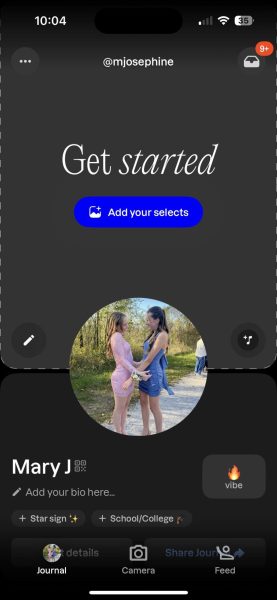
The word “lapse” can be defined as a passage of time, according to Oxford Languages. The social media app “Lapse” has a mission to rewind time, return to an era when film cameras were king, and “reclaim how we take and share memories.”
To achieve this, Lapse presents itself as “an app which turns your iPhone into a disposable camera,” as marketed on its official website. Users have thirty-six shots until their daily “film roll” runs out. Hours after taking a photo, Lapse “develops” the film, meaning users do not have access to their photos until it is finished developing. This also means that users do not have the ability to scrutinize which photos are post-worthy or edit them until they meet that standard, preventing users from curating an inauthentic social media presence. Instead, photos are added to a user’s “journal” (profile) or shared with group chats.
The idea for a low-stress digital photo journal came from London-based brothers Dan and Ben Silvertown who told TechCrunch that they co-founded Lapse after using a point-and-shoot camera during a trip to Vietnam. Using a film camera still allowed the Silvertown brothers to capture memories, but instead of selecting their “best” photos to share with social media followers, they were able to share a full photo journal with a select group of close friends.

The Silvertown brothers secured seed-funding, or financing for their startup business, from Octopus Ventures, Google Ventures, and Speedinvest. These private equity investments paved the way for the initial launch of Lapse in September 2021. Before its release to the general public, Lapse was available exclusively to beta testers. The limited audience managed to raise demand for the app which briefly landed a spot on top of Apple’s App Store chart. The Silvertown brothers themselves were named among Forbes’ “30 under 30” in the technology industry for the magazine’s 2022 European publication.
Despite this seemingly successful launch, the Silvertown brothers sought to introduce changes to make Lapse reminiscent of more traditional social media platforms. The rebranded version of Lapse debuted in June 2023 with new designs including “memories,” a “featured” page, profile page customizations, opportunities for friends to react to photos, and “instant” photos that are immediately sent to friends and disappear upon receival.
Three months after these changes, on September 23rd, Lapse hit #1 on Apple’s App Store chart, jumping up from #118. Two months later, as of November 23rd, Lapse sat at #11 for top free apps, ahead of both Instagram and Snapchat. TechCrunch reports that of the users who help keep the app on the charts, a whopping 80% reside in the US, with about the same percentage being GenZ females.

Mary Sitzmann and Ella Chuacpoco, two juniors at Dowling Catholic High School who belong to Lapse’s widest demographic, both find issues with the app. In fact, Sitzmann deleted Lapse because of her difficult time using it. She says, “It’s busy and confusing, and I don’t know how to do anything on it,” adding, “the setup takes forever.” While Chuapoco has yet to delete Lapse, she is no avid user. “I kind of forgot it was there [on her homescreen],” she says. Chuapoco’s experience is not unusual; in fact, only 15% of those who download Lapse continue to use it after creating an account, so eventually, it’s only a matter of time before users like Chuapoco follow Sitzmann’s lead and delete it from their home screen.
Since its launch in 2021, Lapse has been free to install, free to use, and free of ads. These user-perks have proved effective at getting people in the door, even if they don’t stay. In an interview with TIME, Dan Silvertown says that “building an amazing product and getting it out to as many people as we can” is enough for now. However, with zero revenue coming from in-app advertisements and no profit being made by selling user data, Lapse is strictly relying on investors to fund growth, but in order to grow into an established tech-company, Lapse will need to start making money. In the same TIME interview, Dan Silvertown hints that this need may soon be met by “something along the lines of paid features.”
Their absence of revenue also means that Lapse relies on users to market the app. To do this, it employs an invite-only approach which, as echoed by their chart numbers, has proved to be incredibly effective for the company (even if it’s incredibly cumbersome for users at the same time). Before activating an account, the app requires every user to invite five contacts to join by texting automated messages such as “try this with me.” Once users are in, they must then “friend” eight other users to create a group chat. Even then, each photo is watermarked by the Lapse logo brand to continue to market its product.

While Lapse positions itself as a sort of anti-Instagram, it seems that its distinguishing features are not all that different from those of other social media giants. Lapse’s “film roll” is really just a chronological organization of photos like Instagram’s photo grid; emojis and “vibes” that friends use to react to photos are only filling in for the like button and comment section; the music, zodiac signs, and emojis on a Lapse profile page take the place of any traditional bio section; “instant” photos foster the same empty social interactions that Snapchat offers; the Lapse “featured” page seeks online validation just as much as appearing on TikTok’s “for you page” to gain likes and followers; and finally, the “friends-only” that Lapse boasts is merely a different label for “followers” (in fact, users can still compare who other users’ friends are).
Amidst these facades to stand out against competition, Lapse also manages to stunt the power of smartphone cameras. The app only offers static photos from the back camera of phones. To add, users are unable to zoom-in nor apply the built-in film filter to previously taken photos.
In spite of this all, Lapse continues to compete with the likes of Instagram, TikTok, and Snapchat. While ancillary investments and intensive user demands keep the app alive, it is the strategic ploy on nostalgia that captures users. In a conversation with the American Psychological Association, Dr. Krystine Batcho describes the two types of nostalgia, personal and historical. Personal nostalgia, she says, “stimulates memories of the times when we were accepted and loved unconditionally.” Historical nostalgia, on the other hand, is “triggered by dissatisfaction with the present.” Often, nostalgia is felt to bring comfort during change, so it can work as a sign of unrest in people. Through her research, Batcho infers that the increased use of nostalgia today, most dramatic in young adults who are teetering on the brink of childhood and adult independence, points to lacking personal connection and sense of purpose.
Accordingly, Lapse has exploited nostalgia in order to connect with their target demographic, young adults of GenZ who are the first to navigate through-the-screen-relationships. At the end of the day, regardless of any low-pressure promises, Lapse is another social media app and can only be so different from its counterparts. For now, comfort found in its nostalgic designs are able to yield high user engagement, but will an app focused on the past be able to remain a part of the future?



